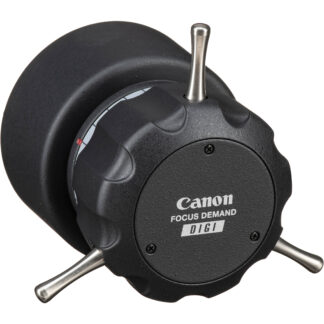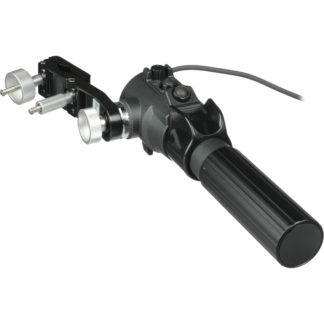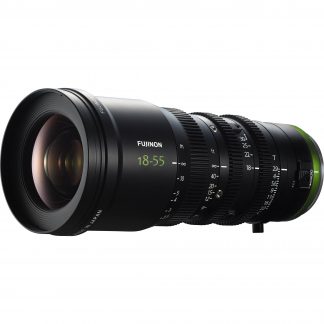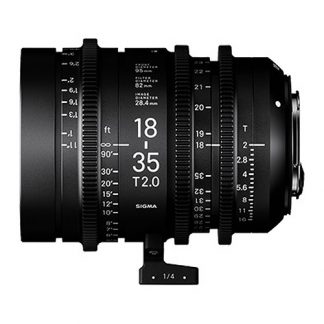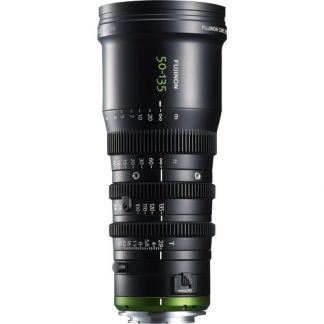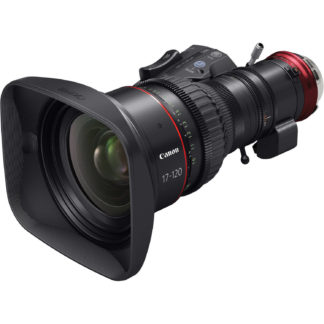Description
The Canon 17-120mm T2.95 is an ENG-style servo zoom lens. It is designed for cinema cameras with Super 35 sensors. In addition, it is suitable for 4K acquisition. Also included are a detachable drive mechanism and support for rod attachment. This makes the lens equally at home with a solo camera operator or full production team.
With a 17 to 120mm focal length, the lens features 7x zoom and has a maximum aperture of T 2.95. Additionally, it features an 11 blade iris to create circular bokeh. For ENG-style shooters the lens drive features servo motors powering zoom, focus, and iris. The lens connection to camera is via a standard 12-pin connector. Alternatively, it will communicate directly through the lens mount when attached to a compatible camera. Connect Canon and third-party zoom, focus, and iris controllers via three 20-pin connectors below the servo.
Broadcast-Style Shooting
Suitable for Shoulder Mounted Camera Operation
- The CN-E 17-120mm features the form factor and control layout of a typical ENG lens. Also, it is designed to be simple for a single camera operator to control while using the camera shoulder mounted. The zoom servo is controlled by rocker with the right hand. In addition, focus and iris can be operated manually with the left hand
Support for Standard Broadcast Lens Controllers
- The lens is compatible with many 20-pin zoom and focus controllers. This allows the lens to be operated comfortably in a studio tripod or pedestal configuration or remotely. Compatible controllers include the Canon FPD-400D focus control and the Canon ZSD-300D zoom control
Variable Speed Servo
- High speed servo-driven zoom and iris is available for critical situations such as while filming sports or fast action. Meanwhile, slower speed settings are available for more expressive work.
Immediate System Startup
- The drive unit features a high-performance encoder so that the lens requires no initialisation. The result is a system without any boot-up delay.
Supports Virtual Image Data Output
- A 20-pin connector below the servo connects to an external system to collect 16-bit virtual image data.
Standard Broadcast 12-Pin Camera Interface Cable
- The lens features the same 12-pin camera interface for power and serial data as found on regular Canon broadcast lenses
Broadcast Lens-Style Focus Ring
- In addition to servo zoom, focus, and iris, the 17-120 features a knurled focus ring. This is a limited 180° rotation.
Angle of View Shift Suppression
- The lens features a three-group inner focus system. The result is minimal breathing when focusing the lens. This ensures stable framing even during rack focus.
Flange-Back Adjustment
- The flange back is adjusted as standard broadcast lenses. As a result, transitions between different camera systems are simplified.
Macro Function
- The zoom ring features a broadcast lens-style release. Thus allowing the lens to quickly set to macro or back again
Fully Closing Iris
- The iris may be closed fully for setting camera black balance or other calibration procedures
Cinema-Style Shooting
Detachable Drive Unit
- The motor unit housing the servo motors and zoom rocker may be removed. As a result, is a cinema style lens with manual control.
Supports Super 35mm Image Sensors
- The CN-E 17-120mm provides a sufficiently large image circle to cover a Super 35mm sensor
Easier-to-Read Ring Markings
- The lens incorporates the following features designed to make the markings easier to read:
- Focus ring markings are angled, making them visible to an operator sitting behind the camera.
- Each ring marking is visible on both sides of a lens. Consequently, focus-pullers and camera assistants can operate the lens from various positions. Additionally, markings are visible in the dark.
- The focus ring features both metric and imperial scales (meters and feet). Therefore, you do not have to replace the lens ring to suit users accustomed to different units of measure.
Support for Cinema Lens Accessories
- The lens is compatible with a wide array of accessories common in the cine industry. For example, matte boxes, follow focuses, and electronic and wireless controllers. The focus ring features both a 0.8mm pitch cine standard gear ring as well as a 0.5mm Canon pitch ring. Finally, the zoom features a 0.5mm Canon pitch, and a 0.4mm pitch iris gear.
Compatible with Lens Support
- Because of the weight of the lens support may be necessary. To clarify, this is achieved using a 15mm or 19mm rod system.
Lens-to-Camera Metadata Transmission
- The lens communicates directly with Cinema EOS camera through the lens interface. This allows lens metadata such as zoom setting and iris to recorded in the camera.
In addition the lens features a standard 12-pin broadcast camera interface and can also transmit zoom, focus, and iris data to a camera or other device via this connection
11-Blade Aperture Design
- The lens features 11 aperture blades to make lens bokeh as close to round as possible. For example, with fewer blades it is often possible to see the geometric shape of the aperture. Additionally, using an odd number of blades helps prevent diffraction effects, such as unwanted “staring” effects.
Lens Design
Aspherical Lens Technology
- Spherical lenses refract more in the periphery degrading sharpness across the image frame. Aspherical lenses, on the other hand, are able to maintain much more even focusing across the image. As a result, more uniform focusing is acheived. In addition, it means less elements are required in the lens design. Thus helping make it not only sharper, but reducing the size and weight.
Canon Fluorite Coating
- Because glass lenses can never be totally free from chromatic aberration Canon applies a special coating, fluorite. Consequently, this reduces aberration.
UD and Hi-UD Glasses
- In addition to fluorite, the use of ultra-low dispersion (UD) glass. So, the result is reduced chromatic aberration.
Please note:This lens is available by special order only. We cannot guarantee its availability

